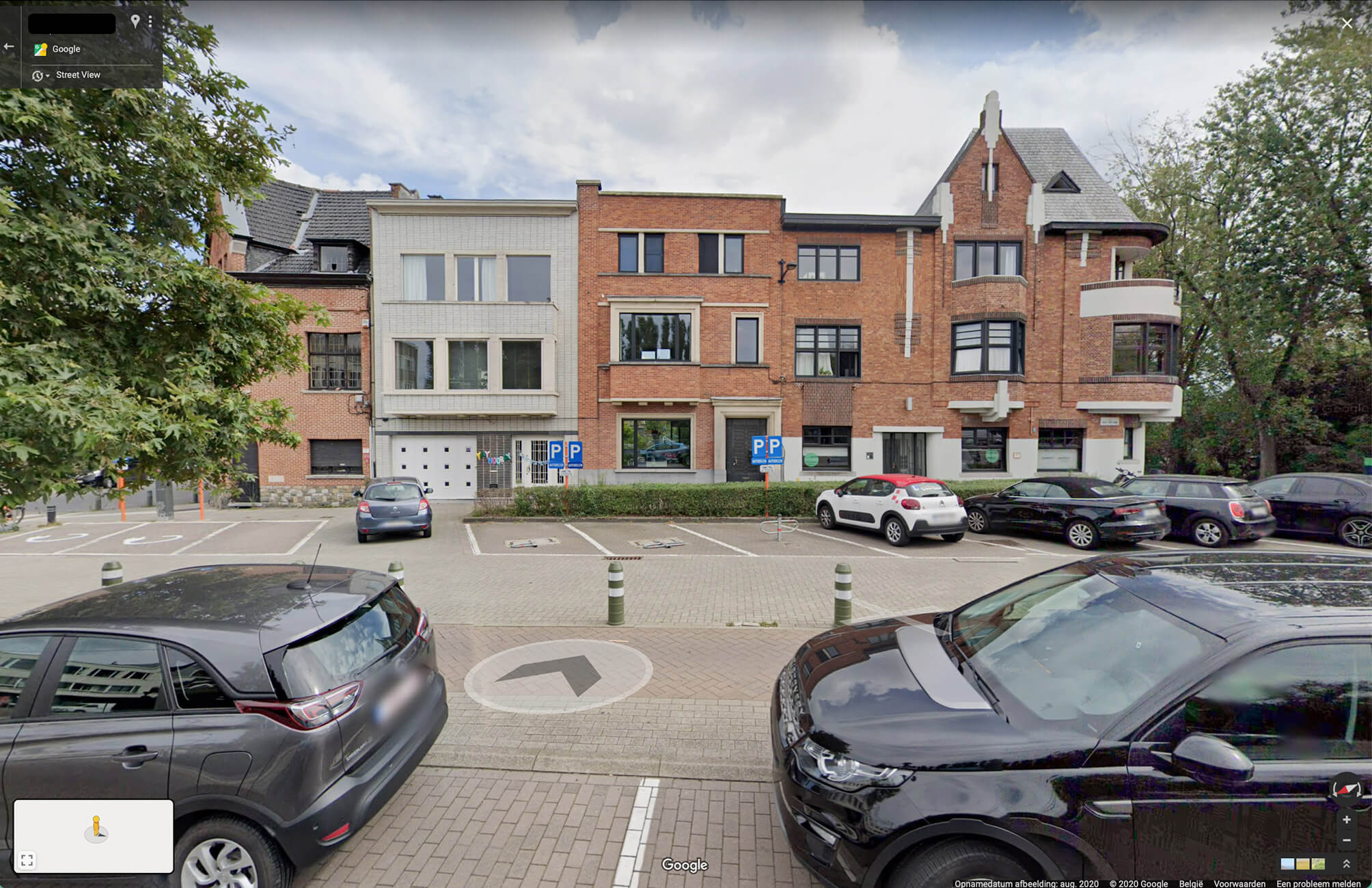What constitutes a ‘document’ and how does it function?
According to the Oxford English Dictionary, the etymological origin is the Latin ‘documentum’, meaning ‘lesson, proof, instance, specimen’. As a verb, it is ‘to prove or support (something) by documentary evidence’, and ‘to provide with documents’. The online version of the OED includes a draft addition, whereby a document (as a noun) is ‘a collection of data in digital form that is considered a single item and typically has a unique filename by which it can be stored, retrieved, or transmitted (as a file, a spreadsheet, or a graphic)’. The current use of the noun ‘document’ is defined as ‘something written, inscribed, etc., which furnishes evidence or information upon any subject, as a manuscript, title-deed, tomb-stone, coin, picture, etc.’ (emphasis added).
Both ‘something’ and that first ‘etc.’ leave ample room for discussion. A document doubts whether it functions as something unique, or as something reproducible. A passport is a document, but a flyer equally so. Moreover, there is a circular reasoning: to document is ‘to provide with documents’. Defining (the functioning of) a document most likely involves ideas of communication, information, evidence, inscriptions, and implies notions of objectivity and neutrality – but the document is neither reducible to one of them, nor is it equal to their sum. It is hard to pinpoint it, as it disperses into and is affected by other fields: it is intrinsically tied to the history of media and to important currents in literature, photography and art; it is linked to epistemic and power structures. However ubiquitous it is, as an often tangible thing in our environment, and as a concept, a document deranges.
the-documents.org continuously gathers documents and provides them with a short textual description, explanation,
or digression, written by multiple authors. In Paper Knowledge, Lisa Gitelman paraphrases ‘documentalist’ Suzanne Briet, stating that ‘an antelope running wild would not be a document, but an antelope taken into a zoo would be one, presumably because it would then be framed – or reframed – as an example, specimen, or instance’. The gathered files are all documents – if they weren’t before publication, they now are. That is what the-documents.org, irreversibly, does. It is a zoo turning an antelope into an ‘antelope’.
As you made your way through the collection,
the-documents.org tracked the entries you viewed.
It documented your path through the website.
As such, the time spent on the-documents.org turned
into this – a new document.
This document was compiled by ____ on 03.02.2022 22:46, printed on ____ and contains 24 documents on _ pages.
(https://the-documents.org/log/03-02-2022-3754/)
the-documents.org is a project created and edited by De Cleene De Cleene; design & development by atelier Haegeman Temmerman.
the-documents.org has been online since 23.05.2021.
- De Cleene De Cleene is Michiel De Cleene and Arnout De Cleene. Together they form a research group that focusses on novel ways of approaching the everyday, by artistic means and from a cultural and critical perspective.
www.decleenedecleene.be / info@decleenedecleene.be - This project was made possible with the support of the Flemish Government and KASK & Conservatorium, the school of arts of HOGENT and Howest. It is part of the research project Documenting Objects, financed by the HOGENT Arts Research Fund.
- Briet, S. Qu’est-ce que la documentation? Paris: Edit, 1951.
- Gitelman, L. Paper Knowledge. Toward a Media History of Documents.
Durham/ London: Duke University Press, 2014. - Oxford English Dictionary Online. Accessed on 13.05.2021.

At a dental practice, the white Alligat®-powder is mixed with the right amount of water to get a mouldable dough that is pressed upon a patient’s teeth. After thirty seconds, the Alligat®-dough stiffens and takes on a rubber-like quality. At that point, still white, it must be removed from the patient’s mouth. Over the next few hours, the mould turns increasingly pink as the substance becomes less humid. Now, it can be used as a mould to create a positive master cast of the patient’s teeth.
Outside the dental practice, the powder’s possibilities remain to be fully explored.

First published as part of De Cleene De Cleene. ‘Amidst the Fire, I Was Not Burnt’, Trigger (Special issue: Uncertainty), 2. FOMU/Fw:Books, 25-30
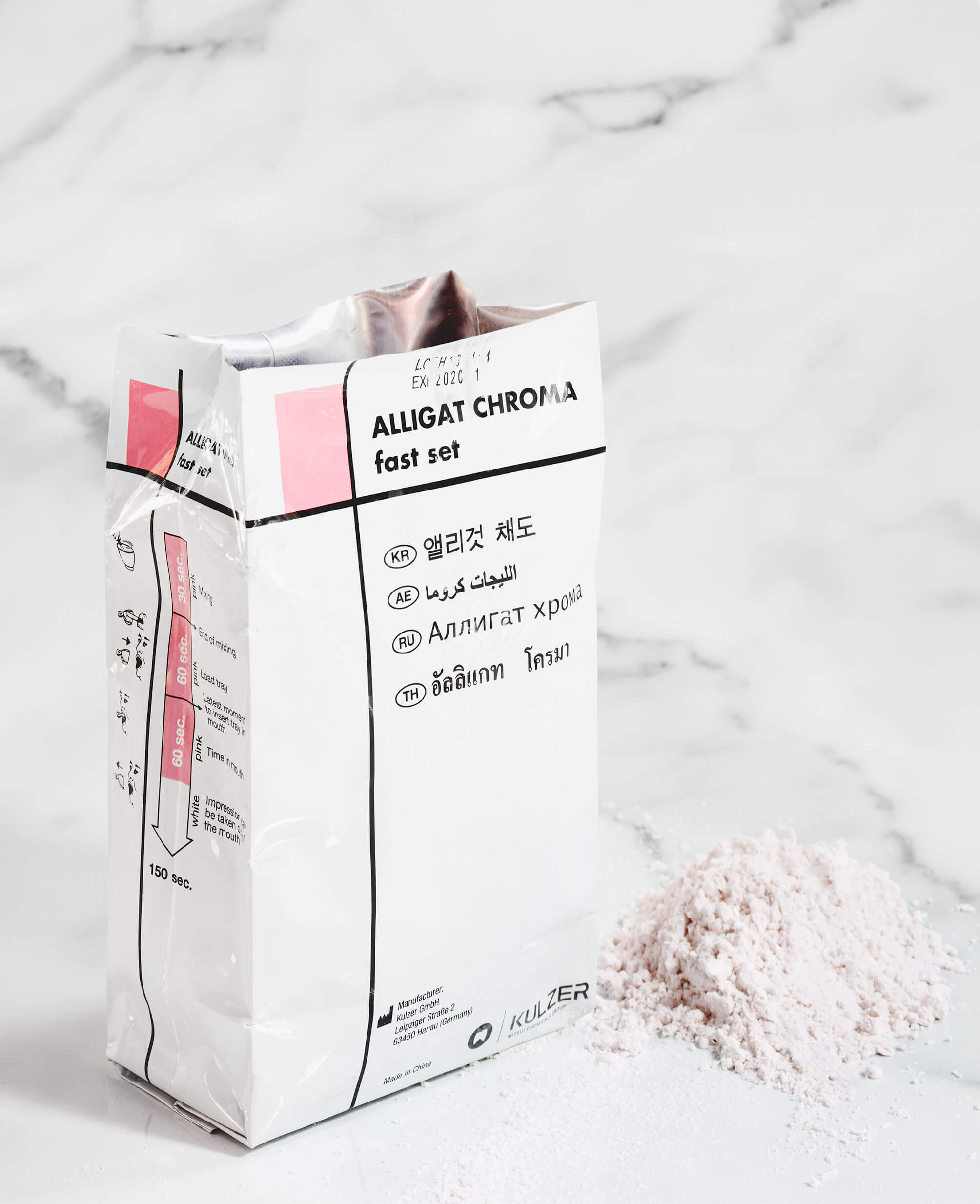
Article 75 of the Royal Decree containing general regulations for road traffic and the use of public roads, published in Het Belgisch Staatsblad on 9 December 1975, lists the rules for longitudinal markings indicating the edge of the roadway.
According to 75.1, there are two types of markings that indicate the actual edge of the roadway: a white, continuous stripe and a yellow interrupted line. The former is mainly used to make the edge of the roadway more visible; the latter indicates that parking along it is prohibited.
In 75.2, the decree focuses on markings that indicate the imaginary edge of the roadway. Only a broad, white, continuous stripe is permitted for this purpose. The part of the public road on the other side of this line is reserved for standing still and parking, except on motorways and expressways.
https://wegcode.be/wetteksten/secties/kb/wegcode/262-art75

A half a day’s walk from the Fuente Dé teleférico, there are less and less traces of passers-by. The path to Sotres suddenly runs through a lusher green. The fence between two pastures keeps the sheep from crossing and coincides with the border between two regions. A hole in the fence would change the landscape’s hue.

Between the rhinos and the kangaroos in the Antwerp Zoo a wooden footpath curves through a grove of Sequoiadendron Giganteum trees. In the middle of this Californian forest, visitors find the giant slice of a felled tree of the same species. It was brought to the zoo in 1962 and was approximately 650 years old at the time. Eleven labels point out significant moments in history on the tree’s growth rings. They range from zoo- and zoology-related moments (for instance: ‘1901: The Okapi is described as a species’, or ‘1843: Foundation of the RZSA and opening of the Zoo’, or ‘1859: Darwin publishes The Origin of Species’, etc.), to cultural and historical milestones (‘1555: Plantijn starts publishing books in Antwerp’, or ‘1640: Rubens (baroque painter) dies’, or ‘1492: Columbus in America’). Another label points to the last growth ring and reads: ‘1962: this tree is felled and this tree disc is installed at the Zoo.’
The label pointing to the centre of the tree implies a simultaneity between the tree’s first growth year and the Battle of the Golden Spurs in 1302.
On closer inspection the slice seems to consist of two halves that were put together like a jigsaw puzzle. The resulting gap is skilfully patched with what appears to be wood from the same species – possibly even the same mammoth tree.

The 48-inch Oschin Schmidt, a renowned reflecting telescope at Palomar Observatory, California, was used for the Palomar Observatory Sky Survey (POSS), published in 1958, one of the largest photographic surveys of the night sky.
Based on the man’s pipe shadow’s direction, thrown onto the telescope, there is reason to believe an off-camera flash was used to make the picture.
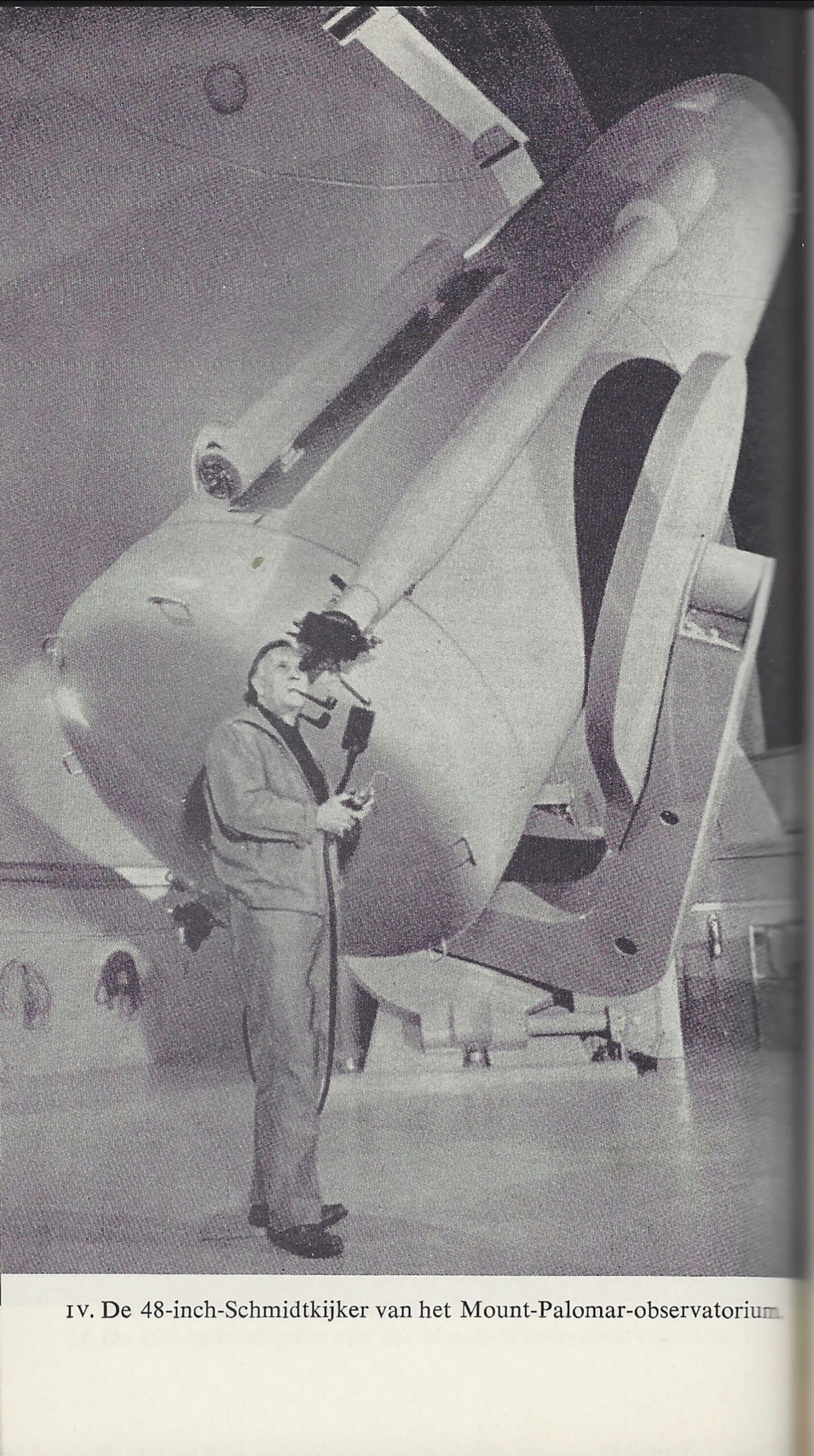
The Authenticity bunkered crude fuel in the Panama Bay. She navigated back and forth between the artificial island Isla Melones and ships leaving or waiting to enter the Panama Canal. On February 14th 2015 she had been moored for a couple of days near the Centennial bridge when the AIS-transponder momentarily signalled the ship’s position in the woods of the Bosque Protector de Arraiján. Afterwards no signal of the ship was received for 41 days, until she reappeared near the port of Bahia Las Minas, at the other side of the Panama Canal.
First published in: De Cleene, M. Reference Guide. Amsterdam: Roma Publications, 2019
Marine Traffic, Authenticity (Caribe Trader, PA), latest position, 09°01’40,71” N 79°38’18,59”W, viewed 14.02.2015, http://www.marinetraffic.com
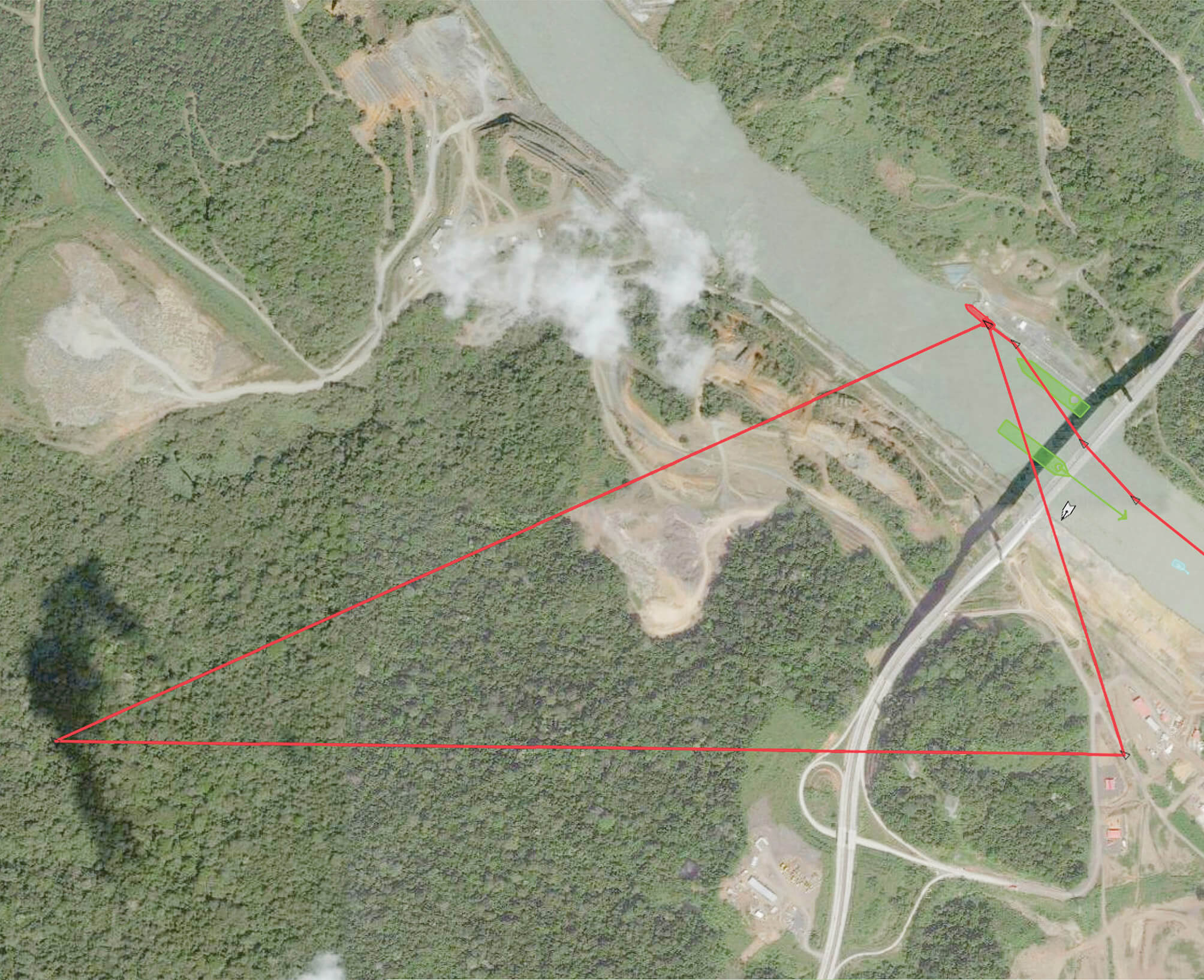
Near Avenue 61 on an artificial island close to Seef, a truck is being towed after the driver lost control over the vehicle and flipped it onto its side. A warm wind blows in from the Persian Gulf.
A police officer signals us to come closer. ‘Why are you taking pictures?’ he asks. ‘This is just an accident. You have to delete the pictures from your phone. Now.’ After checking the pictures-folder on our phones, he gets in his car, drives a few metres, stops the car and rolls down his window. ‘And don’t do it again!’ he yells. Then he drives off, raising a cloud of sand in his wake.
Photograph taken and recovered from my trash bin on 18.12.2020.

Robert Nemiroff and Jerry Bonnell’s lesser known project (R.N. and J.B. being the creators of Astronomy Picture of The Day), was making websites containing over a million of digits of square roots of irrational numbers, e.g. seven. ‘They were computed during spare time on a VAX alpha class machine over the course of a weekend. […] We believe these are the most digits ever computed for the square root of seven on or before 1 April 1994.’ Elsewhere, R.N. states: ‘They are not copyrighted and we do not think it is legally justifiable to copyright such a basic thing as the digits of a commonly used irrational number.’ If one wanted to get a copy of the 10 million digits of the square root of the number e R.N. and J.B. computed in their spare time, one can send an email to R.N. at nemiroff@grossc.gsfc.nasa.gov.
https://apod.nasa.gov/htmltest/gifcity/sqrt7.1mil
https://apod.nasa.gov/htmltest/rjn_dig.html
https://apod.nasa.gov/htmltest/rjn.html

The torn off section of roofing on the grass has part of a text carved in it: ‘UDI’ and ‘EN’ are still legible. It must have come from another roof; the one shown in the photograph has no missing sections, nor visible repairs.
The roofing that is still on the garage shows a drawing of some kind. A floorplan for a squarish building with a supporting column along each side, or the layout for a tactical explanation, perhaps.
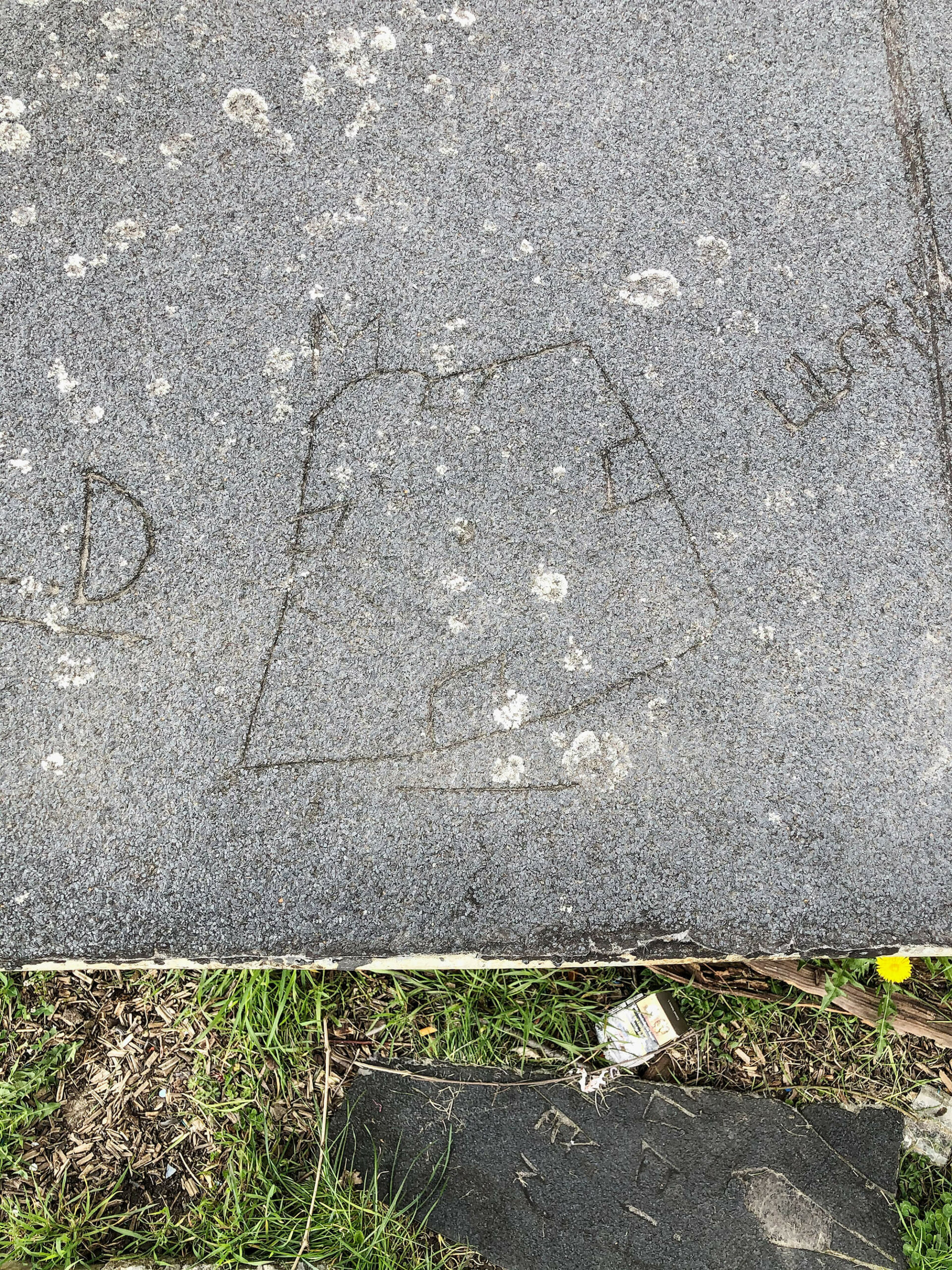
A carving that looks like a stitched-up scar (a long, slightly curved line crossed at a right angle by eleven short straight lines) is inserted into a short statement about Celine and Logan. An initial of Celine’s last name is included. At first sight it looks like a ‘D’, but the line through the middle might just as well make it a ‘B’. Maybe it was Celine D who added the line in an attempt to convince those reading the roofing that it’s actually Celine B who blows Logan.

Anastasio Guzmán was a Spanish pharmacist and naturalist. He spent most of his career in South-America. He died in 1807 during an expedition in the Cordillera de Los Llanganates in Ecuador, in search of the lost treasure of the Incas. Some time after his death, his colleague Juan José Tafalla suggested naming a certain genus of plants after his friend.
Guzmanias are mainly stemless, evergreen, epiphytic perennials native to Florida, the West Indies, southern Mexico, Central America, and northern and western South America.They are found at altitudes of up to 3.500m in the Andean rainforests.
The symbols beneath the photographs indicate that these Guzmanias require full light, but it is advised to avoid bright sunlight in spring and summer (HALF WHITE, HALF BLACK SUN), the compost should be kept moderately moist during growth, allowing it to dry slightly between each watering period (HALF FILLED WATERING CAN). Unlike, for instance, the Grevillea Robusta, a Guzmania does not require being sprayed regularly (SPRAYER). The four digit code is the AUCTION CODE: ‘Every product has a code. This code is indispensable for the trade.’ The COLOURED BAR at the bottom shows the availability of a plant quarterly. RED means good, PINK means moderate and WHITE means not available.
The introduction to this booklet mentions that ‘[p]rinted colours are often not as accurate as the colours of the plants themselves, which is why it is possible that colours shown in pictures in this booklet may be a little different from the colours of the real pot plant.’
Bloemenbureau Holland. Potplanten, pot plants, topfpflanzen, plantes en pot, piante da vaso, planta en particular 1995/96. Leiden: Bloemenbureau Holland, 1995.
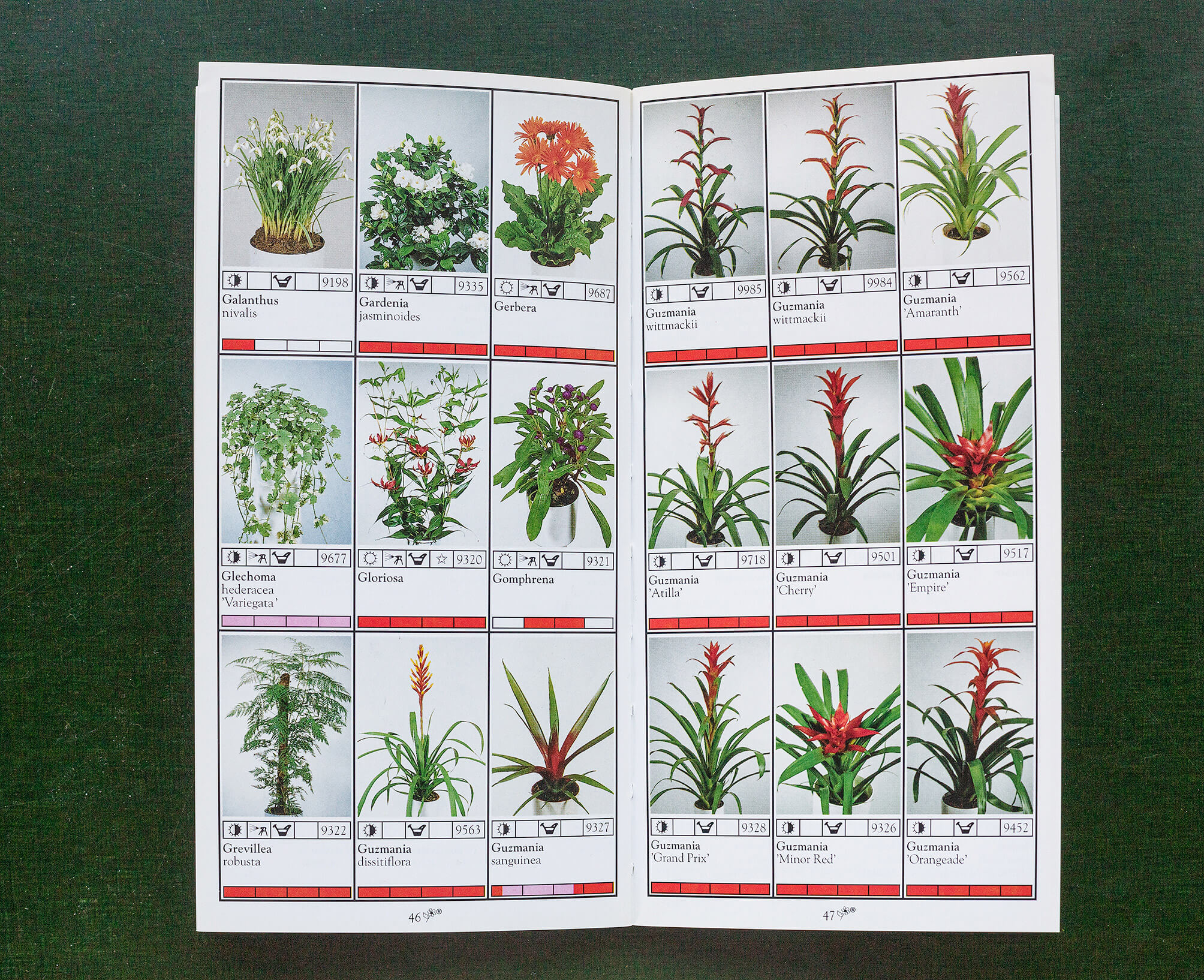
Until recently, for as long as I could remember, the packaging of Tabasco® Pepper Sauce had been unchanged. On the front of the packaging, there is a photograph of a bottle of Tabasco®, scale 1:1, against an orange background.As far as packaged goods go, this is a highly idiosyncratic and quirky example.
The background colour approximates the colour of the liquid inside the bottle, resulting in as good as no contrast. Moreover, as the image of the bottle is scale 1:1, the packaging becomes kind of unnecessary and superfluous, also because the life-sized image of the bottle is the only way information is given to the customer: there are no additional slogans, no repetition of the brand name, no props and no decor. The image of the bottle advertises the bottle. It seems to add nothing the bottle could not do by its own (like a bottle of wine does).
What makes the packaging truly stand out, however, is the fact that the image of the bottle is not positioned vertically, but is slightly askew. It seems to be the result of a design error, and has an amateur feel to it. The decision to keep it as such and not correct it up until today, is, however, a stroke of genius. The non-vertical positioning alters the relation of the image of the bottle to the bottle inside: as the box is standing on a shelf, the tilted image of the bottle undermines its representational superfluousness.

Interior of Eben-Ezer: photocopies and replicas of among other things an Edit du Roy and a photograph of a Marche pour la liberté de conscience, 1956. Handwritten labels are added beneath the blue frames. Due to limited lighting, and an interdiction to use the camera’s flash, some labels are illegible, even when zooming in on the picture. It is unclear what the bottom left replica of a painting is (it has a Brueghelian air to it) and the upper right replica of a photograph.
The walls are made of flint, harvested from quarries in the neighbourhood.
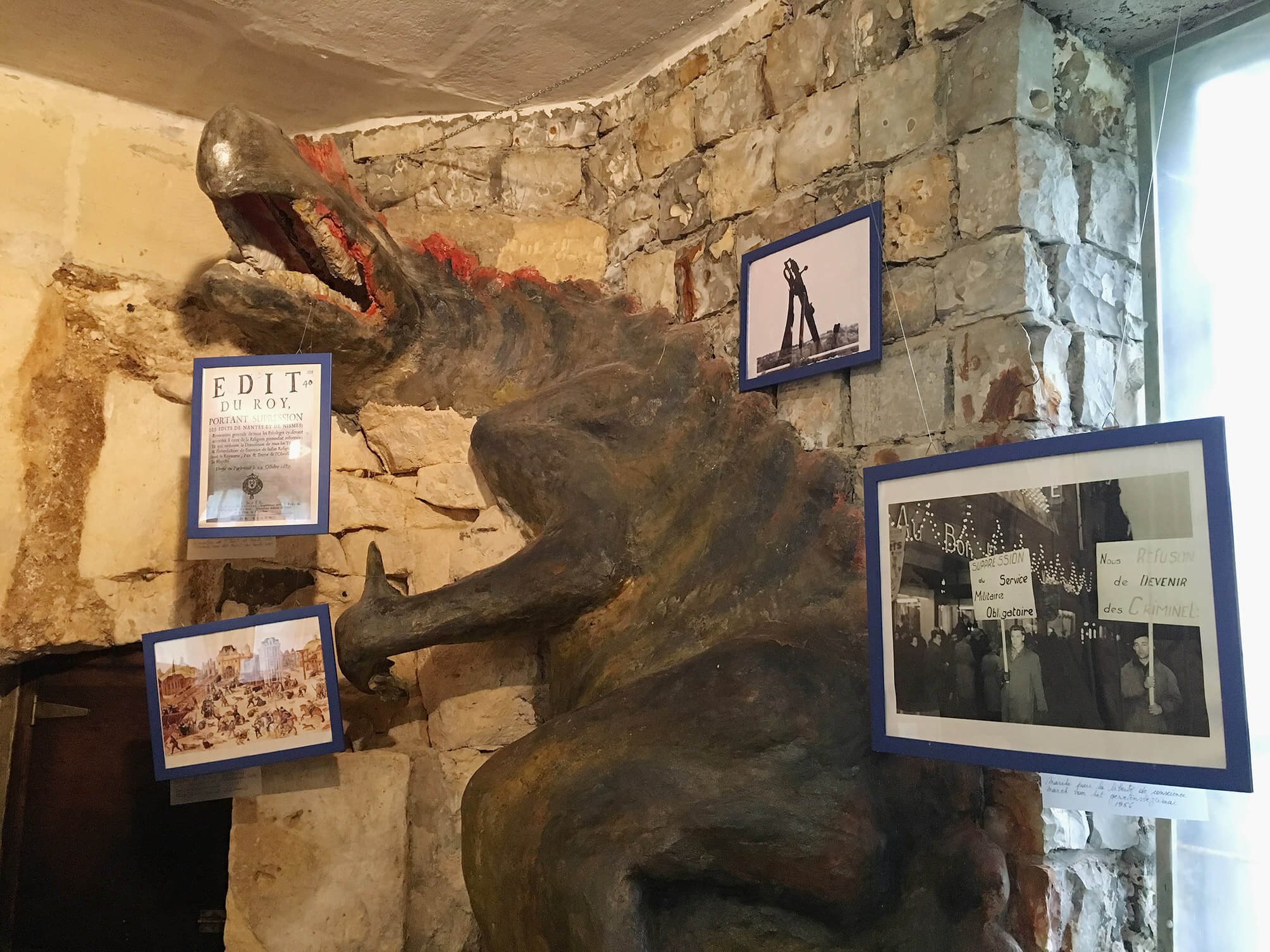
The door leading to the kitchen has a section in stained glass. The other day, I took a closer look at one of the spots on it, which I had half-consciously registered every time I passed it. On two square meters, there are three of them. All are oval in shape. Two of them seem to be flat bubbles of air, haphazardly produced during the manufacturing of the glass, I imagine. The third one, however, is peculiar. It drew my attention because it appeared to represent something. Upon closer investigation, it seemed to allude to different things. A model ship, like the ones in glass bottles. A dragon, like the one used on the Welsh national flag. A tailed, devilish figure riding a cloud-like motorcycle. What skills the glass worker must have had, to produce an image in a glass covered air capsule like this. I closed the door softly, as the microwave’s signal sounded.
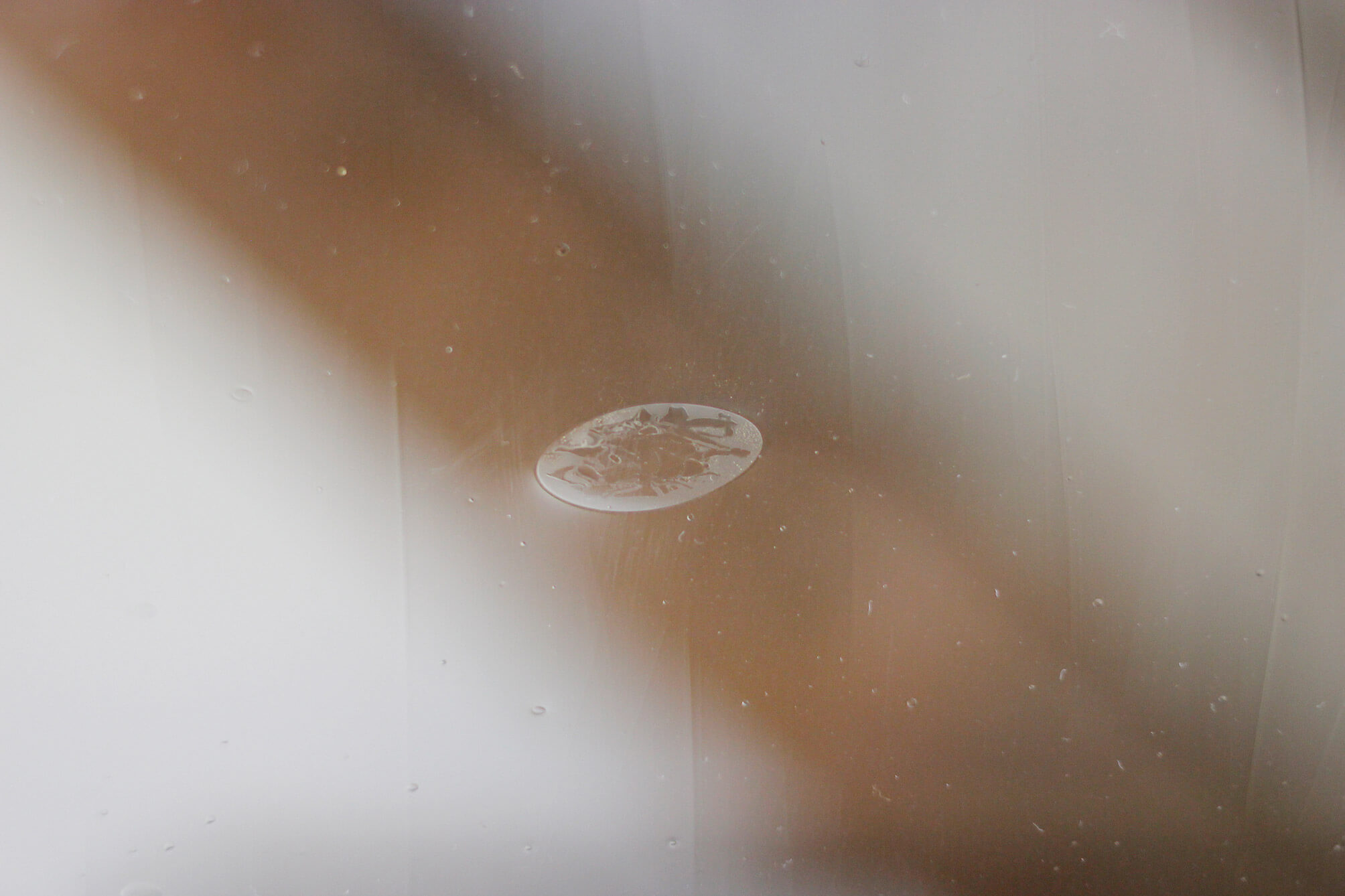
On Wednesday, May 9, 2018 at 2:23:14 PM Koh Elaine starts the thread original or original copy on the The Free Dictionary by Farlex’s forum.
‘Is “original copy” correct or should it be “original”? Thanks.’
The seventh reply to Elaine’s question is Wilmar’s on Thursday (his was preceded by towan52, georgew, NKM, Koh Elaine, Sarrriesfan, ChrisKC, Ashwin Joshi).
‘An original copy IS the original.
Folks usually call the document first created the original, but some will say original copy. If I run that original thru the copy machine, I end up with two copies (yes, I said copies) of the same thing – the original and the duplicate of it (in terms of content). This is how the term is commonly used.
If your writing or conversation depends heavily on understand the difference, I would recommend using the terms original and duplicates. There are many times when that is very important, in that the original must be retained by a particular party, and the duplicates are marked as such and distributed or stored as required depending on the document and the circumstance.
If you are just trying to make sure that you have enough copies to distribute to everyone at the company meeting this afternoon, use whatever terms trips your trigger. But, if you want to ensure that you keep custody of the original, so that you can make additional duplicates (copies) when additional people attend, then be more specific about the words you use.
OH, and, please, in the future, include some context with your question. Asking if “word” is correct doesn’t go very far in supplying a reasonably useful response.’
https://forum.thefreedictionary.com/postst182102_original-or-original-copy.aspx

During the one day course Safety and Avalanches, teacher G.T. shows pictures of different manifestations of snow and ice. If one learns to read them, one can deduce the wind direction when hiking or skiing in mountainous terrain. Wind direction is crucial for assessing the stability of the snow. G.T.’s examples are of Austrian origin. He speaks about ‘Anraum’: displaced snow can get stacked horizontally against an object, such as a tree or a cross. The snow ‘grows and builds into the wind’. Counter-intuitively, the snow points to the side the wind is coming from. One can expect dangerous terrain in the direction of the ‘unbuilt’ side of the object.
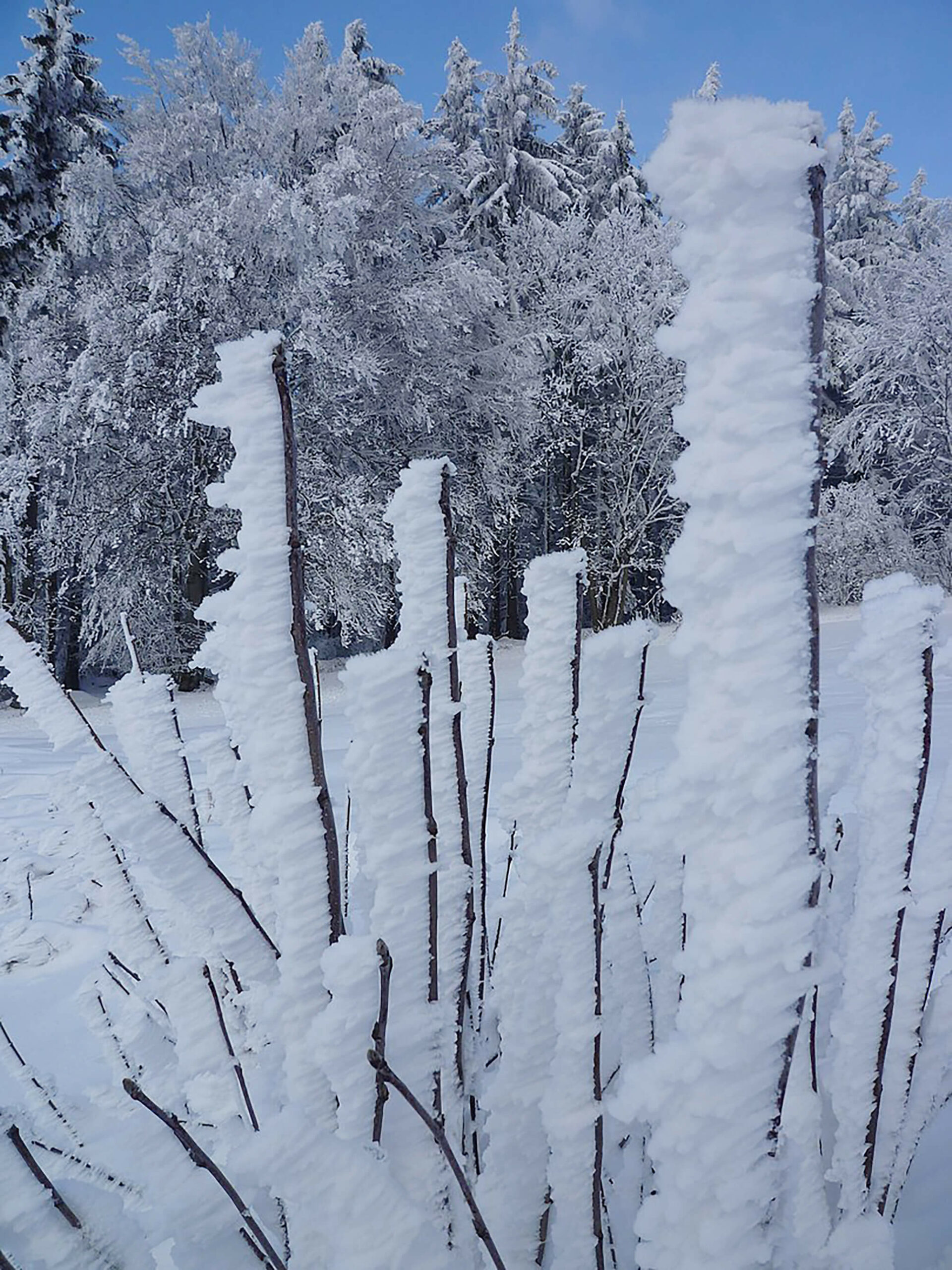
A year before the crash, Swiss artist Charlotte Stuby designed a tailor-made cover for the car. The dents caused by the unfortunate hailstorm weren’t visible. The work, called Gone Fishing, was on view during an open air exhibition on the theme of the parking lot. Heavy wind had caused the temporary traffic signs on the parking lot, left there by the city services, to tip over. One hit a car and caused a scratch. It was unclear if this would be something the insurance company would accept. We attached Stuby’s cover a second time. Parking fines flew irregularly across the lot.
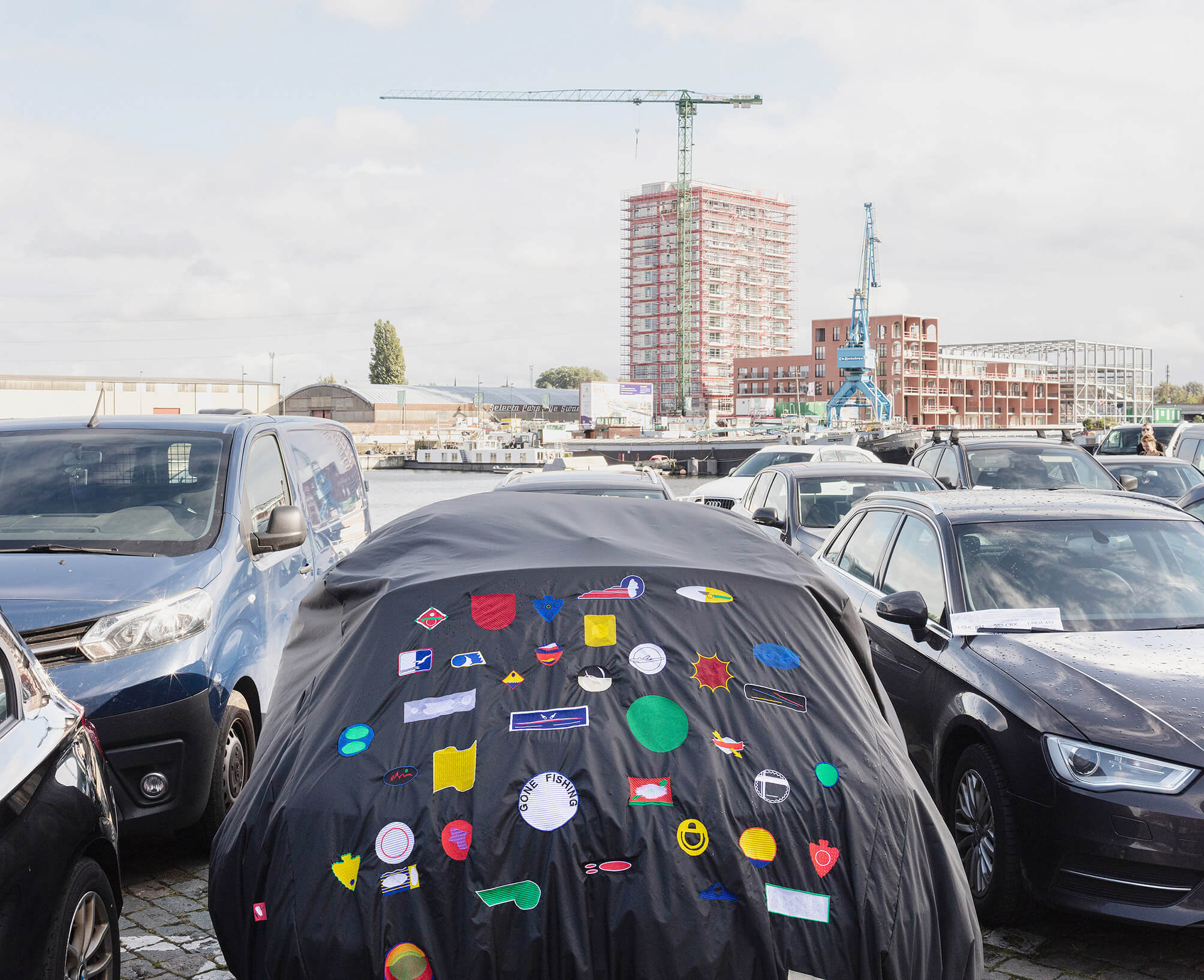
Recreational airfield at Grimbergen, webcam footage.
09:10:00The frame shows the first movement on the terrain. The gate has been opened, the barrier lowered. A black car is in the back. In the forefront, aviation signs on the ground: a yellow cross on a surface painted red; an arrow in a 90° angular shape; two circles connected by a line; a T-shaped line.
09:20:00Two men talking, each one on one side of the barrier. The man on the side of the airstrip has two dogs with him. The aviation signs have changed: the arrow is gone; the horizontal bar of the T-symbol has moved to the other side of the vertical line; one yellow line that made up the cross on the red surface is gone, leaving one yellow diagonal line.
10:09:01A small white aircraft (the two men and the dogs are gone).
10:20:01The aircraft in the same position, with what seems to be an open roof.
10:40:00Aircraft leaving the gas station where it was before.
11:10:01A white car at the gas station, where previously the aircraft was stationed; a silhouette of a man, perhaps.
11:30:01White car gone.
11:50:01Small white aircraft at the gas station; man in red jacket next to the aircraft. Not clear if it is the same aircraft seen in frame 10:09:01.
12:10:01Aircraft appears to be heading for take-off.
12:20:01Aircraft gone.
12:40:01White dots on the grass that appear to be birds.
14:10:00First precipitation: snow, visibility lessens.
14:20:00More snow, wind is stronger; someone has replaced the yellow stripe so that, again, a yellow cross is formed on the red background.
15:10:00The grass and the concrete get increasingly white. No aircrafts, vehicles or persons can be discerned. The aviation signs beneath the thin-layered snow are still visible, and unaltered.
Every so often architects ask me to photograph projects of theirs under a blanket of snow. Snow-days are rare around here. In an attempt to avoid a futile drive along roads in winter conditions, I check webcams near the project-to-be-photographed before setting out.
Webcam Grimbergen, meteobelgie.be: https://www.meteobelgie.be/waarnemingen/belgie/webcam/272/grimbergen
http://www.rvg.be
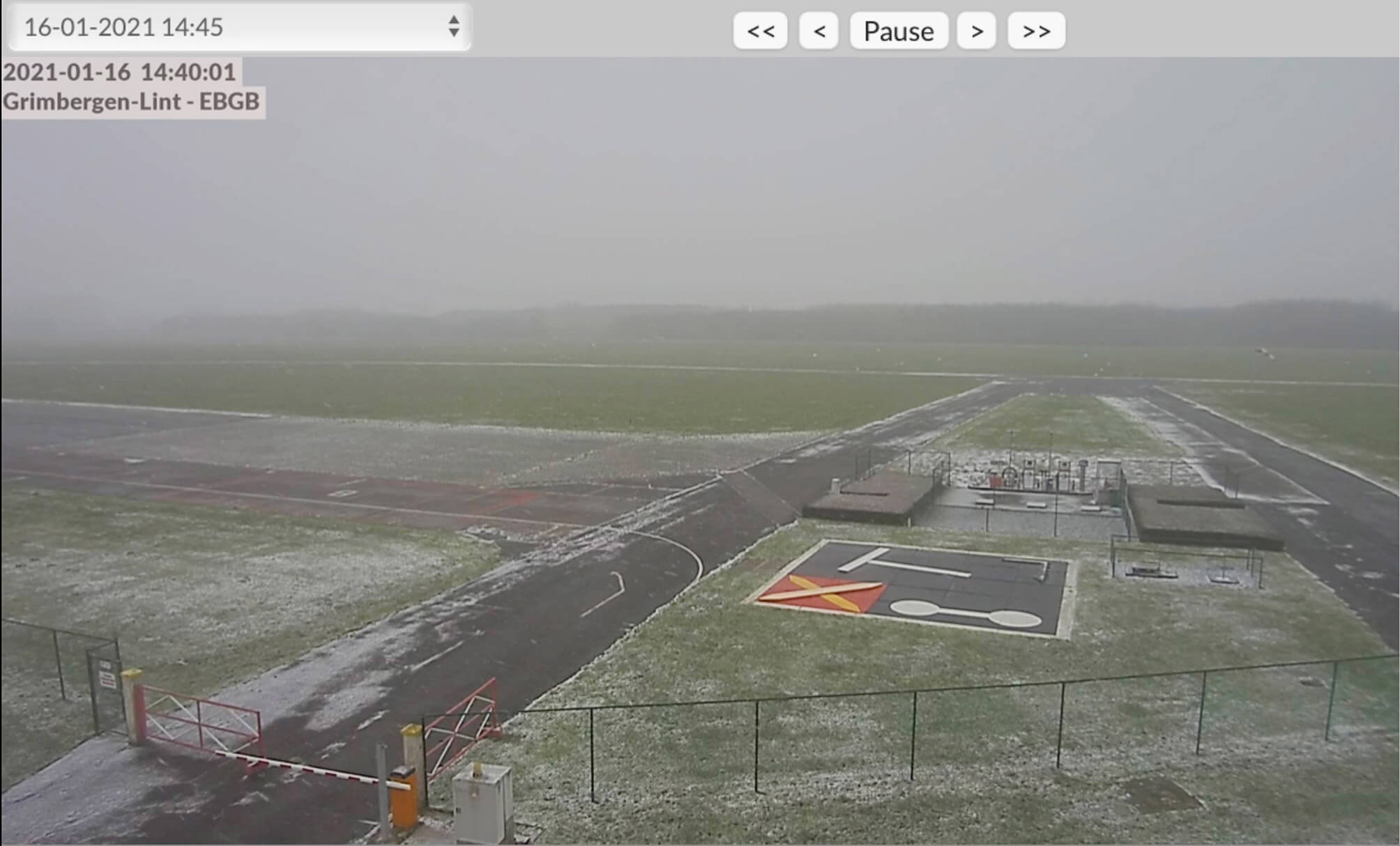
As the hours passed, and while clouds continuously kept us from seeing stars and planets, we started to photograph the set-up used to launch this website. To highlight the umbrella that protected the gear from the unpredictable bursts of rain, we used a flashlight: during the thirty second long exposure, it was lit for two seconds. This proved to be enough to give the whole the feel of an untampered, realistic view. Meanwhile, the website was in all likelihood streaming a grey haze, as the telescope was pointed to the fleeting clouds and gradually spinning along with the earth’s movement to keep track of the same invisible celestial bodies. As we returned to the base, planet Jupiter had become visible to the naked eye.
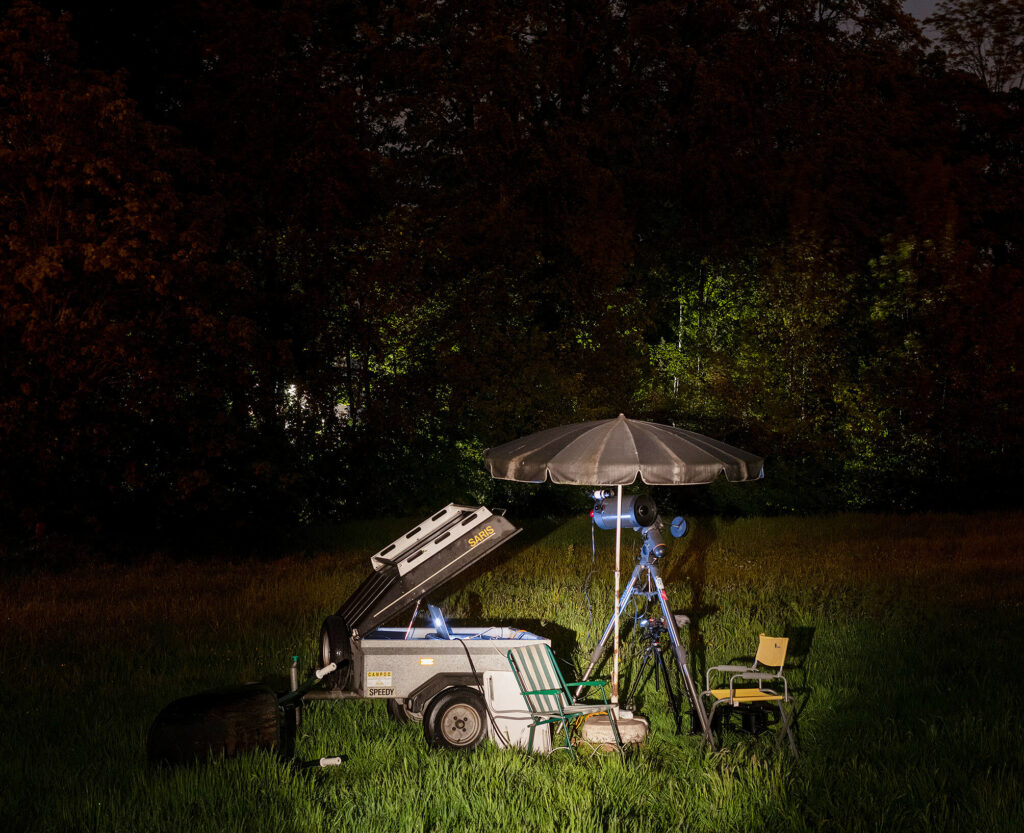
In another exposure of the same length, we left the flashlight on for approximately eight seconds and pointed the beam a bit lower.

Belgium, approximately 1.5km from the French border, photograph made on 16.06.2018.
The European flag symbolises both the European Union and, more broadly, the identity and unity of Europe. It features a circle of 12 gold stars on a blue background. They stand for the ideals of unity, solidarity and harmony among the peoples of Europe. The number of stars has nothing to do with the number of member countries, though the circle is a symbol of unity.1
- Coat of arms of Gmina Puck, a rural district in Puck County, Pomeranian Voivodeship, in northern Poland.
- Illegible.
- F.C. Hansa, Mecklenburg, Pommern, FC Hansa Rostock is a German association football club based in the city of Rostock, Mecklenburg-Vorpommern. They have emerged as one of the most successful clubs from the former East Germany and have made several appearances in the top-flight Bundesliga. Hansa Rostock’s official anthem is “FC Hansa, wir lieben Dich total”. Hansa struggles with hooliganism, estimating up to 500 supporters to be leaning towards violence. The club’s logo consists of a red sailing ship with a blue sail showing the Rostock Griffin.
- Mon École Écologique.org is an organization for environmental conservation. On 07.01.2021 there was no website listed on this URL.
- Illegible.
- Illegible, apart from ’1962’ in the middle.
- Innocenti Bruderschaft, EL, 2018, a community of German Lambretta Innocenti riders and aficionados.
- Imag’Ink, Bretignolles Sur Mer, Tatoueur, 06 06 44 13 51, a French tattoo shop.
- Illegible.
- Hardly legible, the only word that can be made out is ‘Futbolom’: Russian for soccer.
- Kaluga on tour. Kaluga is a Russian city 150km southwest of Moscow. It is often called the cradle of space exploration thanks to the city’s most famous resident: Konstantin Tsiolkovsky.
- Hansa Ultras, F.C. Hansa. The Ultras are a group of F.C. Hansa fans (see: ‘3’).
- Illegible because ‘12’ was stuck over it.
- Illegible.
- La Hutoise is a regional student-association for higher education students from the Belgian town of Huy and its surroundings. Its aim is to bring together students from Huy in a spirit of camaraderie and to perpetuate student folklore. The logo consists of a two headed bird of prey with a cap on each head. The bird wears a scarf over one shoulder and holds a glass of beer in each paw.
- F.C. Hansa, Grimmen. The F.C. Hansa logo (see ‘3’ and ‘12’) is combined with the coat of arms of Grimmen: a griffin on a pile of 10 bricks. Grimmen is a German town in Nordvorpommern on the banks of the river Trebel.
- Illegible.
- Heil Hansa. To the left of this text the F.C. Hansa logo (see ‘3’, ‘12’ and ‘16’), on the right a logo consisting of a black bull with his tongue out and a golden crown on his head. This controversial sticker lead to several arrests in the run-up to the match between F.C. Hansa Rostock and Bayern München in February 2020. Supporters of F.C. Hansa had attached this sticker to public buildings on their way to the stadium.
- Illegible because ‘16’ was stuck over it.
- The Cuban flag.
- Illegible.
- Illegible.
- Kaluga (see ‘11’).
- De Veterinnen, a round, black sticker with a red print of a head wearing a round hat and a carnivalesque collar with a carrot for a nose. No further information found.
- Zlombol 11. Złombol is a yearly charity car rally racing event that starts in Katowice Poland. Contesters must drive a car that was built or designed during the communist era. The destination of the 2011 edition was Loch Ness.
- F.C. Hansa, Mecklenburg, Pommern, identical sticker to ‘3’, see also ‘12’, ‘16’, and ‘18’.
- Torpedo Moscow, only for white. Football club Torpedo Moscow is a Russian professional club based in Moscow, founded in 1930. Some fans of the club wave far-right symbols and banners, both during and outside of matches. Massive fan-protest ensued when the club tried to sign a black player in 2018. The player’s contract was cancelled.
- Heil Hansa. See ‘3’, ‘12’, ‘16’, ‘18’ and ‘26’.
- Illegible.
- Illegible.
- Illegible.
- Illegible.
- F.C. Hansa. Variation of ‘3’ and ‘26’ with a circle of yellow crops around the logo. See also ‘12’, ‘16’, ‘18’ and ‘28’.
- Live animals, contents: Rivne UA. These stickers are required by the International Air Transport Association for airline cargo pet travel. Rivne is a city in western Ukraine (UA) with an international airport. The sticker does not specify the transported animal but displays a dog, two birds, two fish and a turtle.
- Illegible.
- Illegible.
- Illegible.
- Illegible, apart from ‘lska’ on the bottom.
- Norrland Fly Guys, Reading Water. The sticker displays a minimal landscape with two pine trees, and a shed on a chunk of floating ice, a single four-point star shines in the sky. Norrland is the northernmost part of Sweden. No further information found. Whether the ‘fly guys’ own airplanes or are involved in fly fishing is unclear.
- This sticker displays – what appears to be – a smiling potato in front of an enlarged snow crystal. No further information found.
- Traumsucht is an artist collective from Berlin. Their website lists German rap-artists
- Illegible.
https://europa.eu/european-union/about-eu/symbols/flag_en
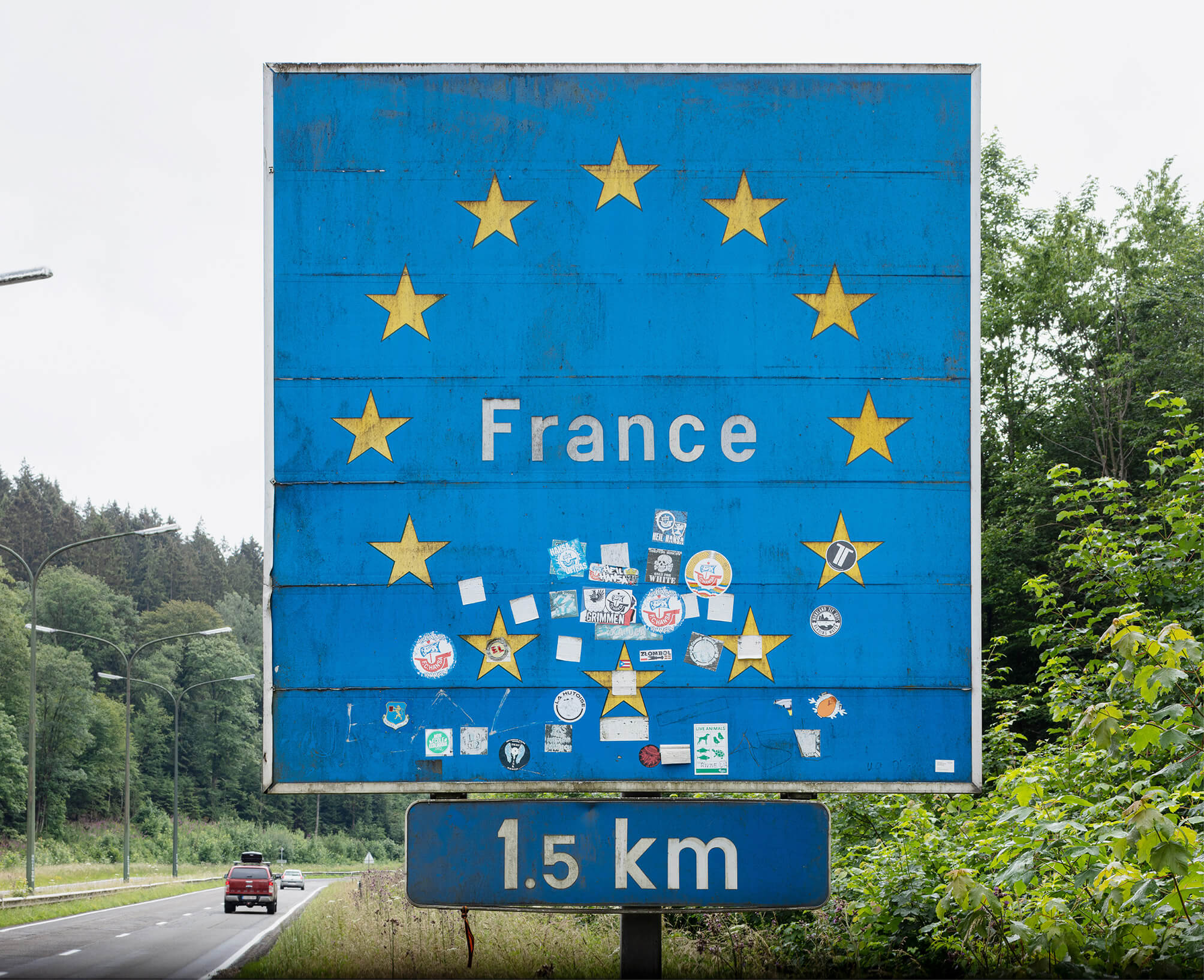
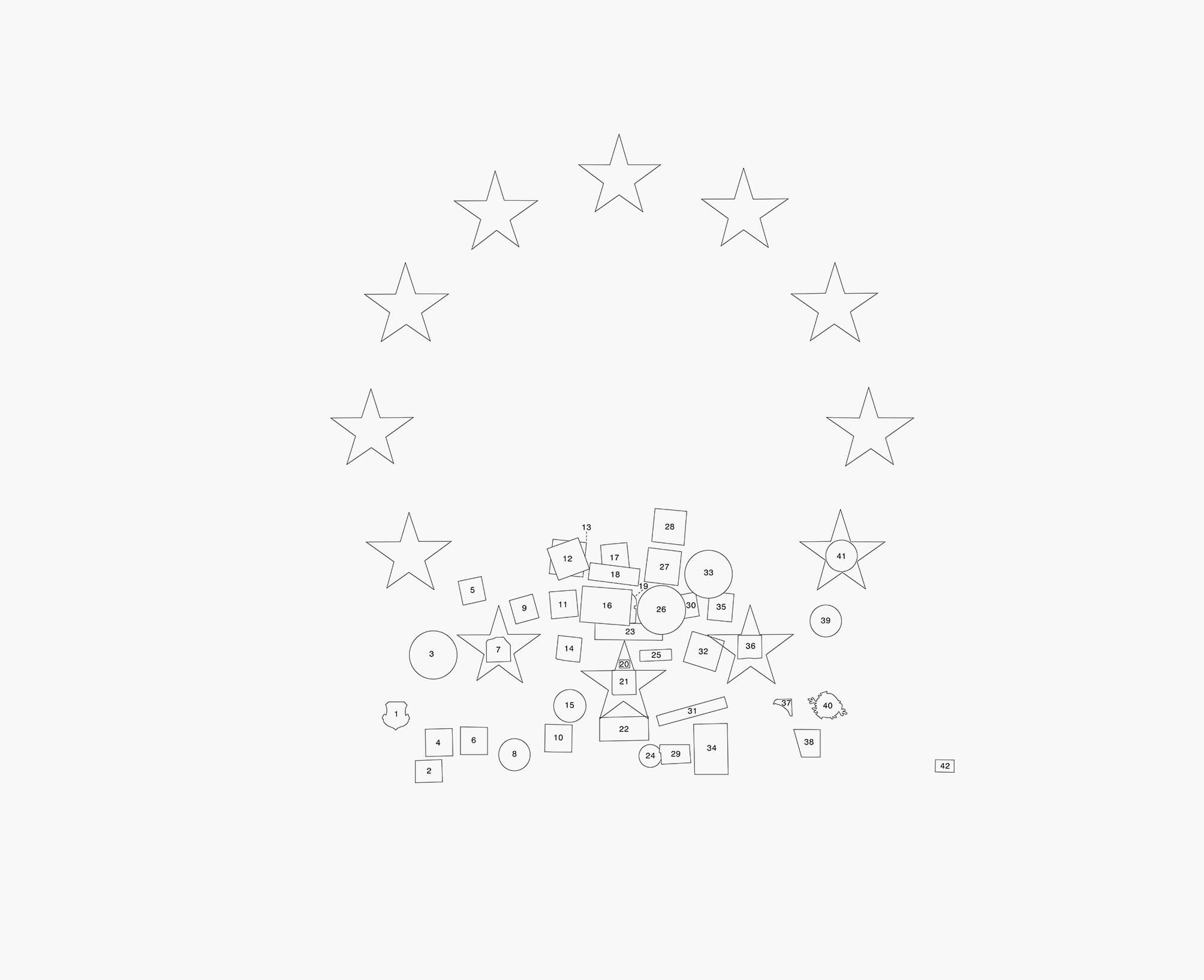
In his Handboek Varende Scheepsmodellen (Handbook Sailing Ship Models) André Veenstra explains the different classes in ship model-competitions. There’s a wide variety. For static ship models the most important one is ‘truth-to-nature’. A jury compares the model to photographs of the actual ship and brings into account categories such as amount of work, degree of difficulty, scale ratio, construction execution and painting.
The most interesting class – according to Veenstra – is F 6. In this particular class, a number of participants with different boats will form a team. Together, they will perform a certain ‘act’ with a maximum duration of ten minutes. During the act, they mimic a slice of reality. Such as, for example, ‘rescuing’ and towing a ship in distress; extinguishing a fire on a tanker or oil rig, lichen and/or tow the sunken wreckage to the harbor, stage a naval battle, etc.
Page 262 shows a photograph of such a mimicked slice of reality. The caption explains: ‘Image 14.15. The Dutch demonstration in the F 6 class during the European Championship of 1975: the oil rig is set on fire by a motorboat with terrorists. The fire is extinguished and the oil rig is quickly towed to a safe harbor by tugs. The show was performed by six people and took a very creditable fourth place.’

An architect in Z. receives a reminder. ‘Please send, as soon as possible, the plans of the construction before the damage.’ The reminder was sent by the Ministry of Reconstruction, in 1951. The architect’s address in Z., as mentioned in this file, is nowadays a house adjacent to Saloon Redbarn, a hall used for activities organized by a club of country and western-aficionados.
Semi-translucent paper, typoscript, stamps, handwritten notes and signature, from the archive of architect O. Clemminck, file ‘Remi Van Bockstael’
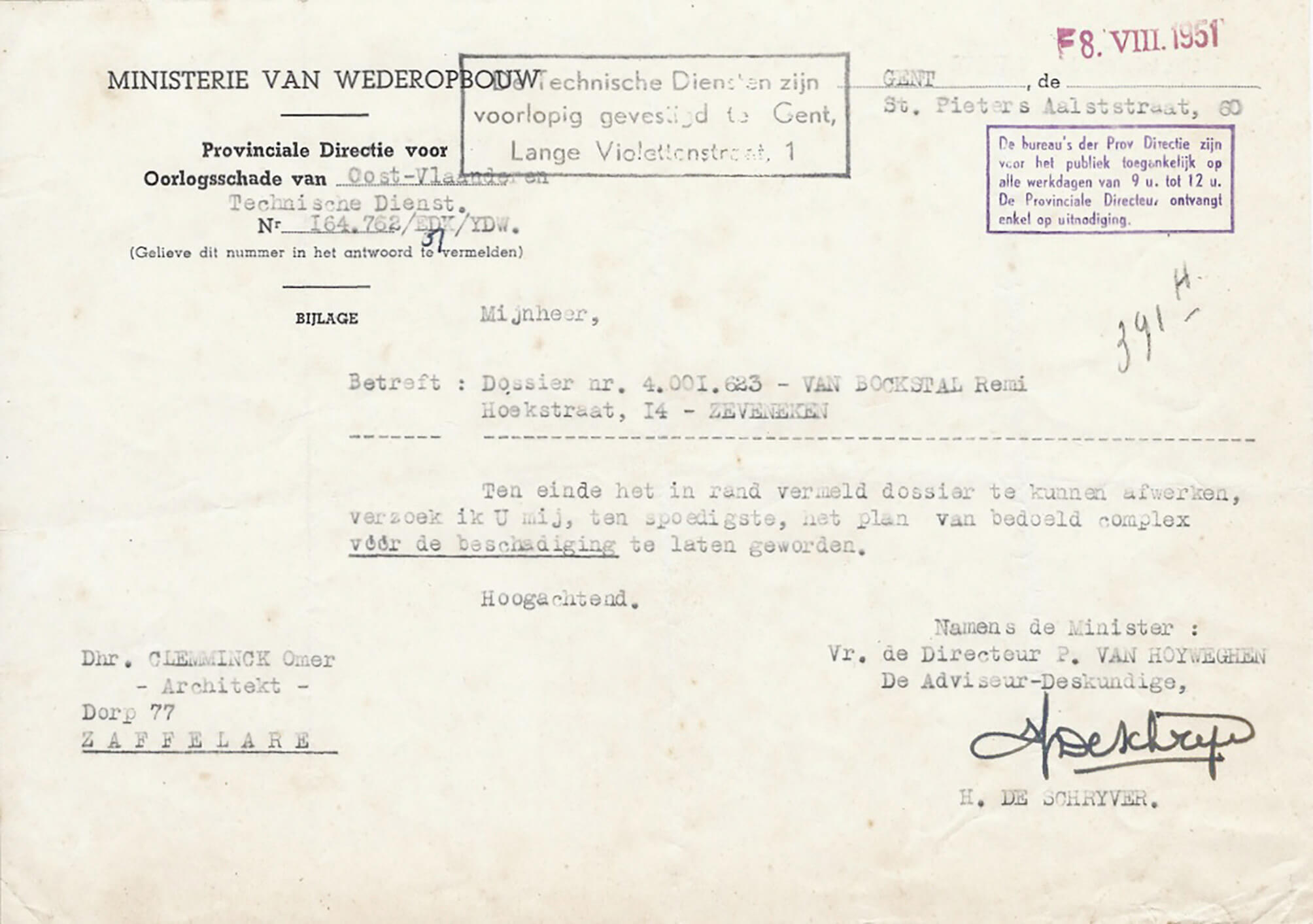
A block of concrete. Fissures are showing and rebar is sticking out from all sides. If it were still straight, the block would measure approximately 130 x 15 x 40cm.
It is lying by the side of the road, a few hundred meters from a construction site. It appears to be shaped by impact. Maybe the block plummeted to the ground from a great height. Perhaps, something heavy hit it. For all one knows, it served as a column and was exposed to an unforeseen amount of pressure, causing it to buckle.
According to Eyal Weizman ‘[a]rchitecture emerges as a documentary form, not because photographs of it circulate in the public domain but rather because it performs variations on the following three things: it registers the effect of force fields, it contains or stores these forces in material deformations, and, with the help of other mediating technologies and the forum, it transmits this information further.’1
Weizman, E. ‘Introduction’, in: Forensic Architecture. Forensis. The Architecture of Public Truth. London/Berlin: Sternberg Press, 2014.
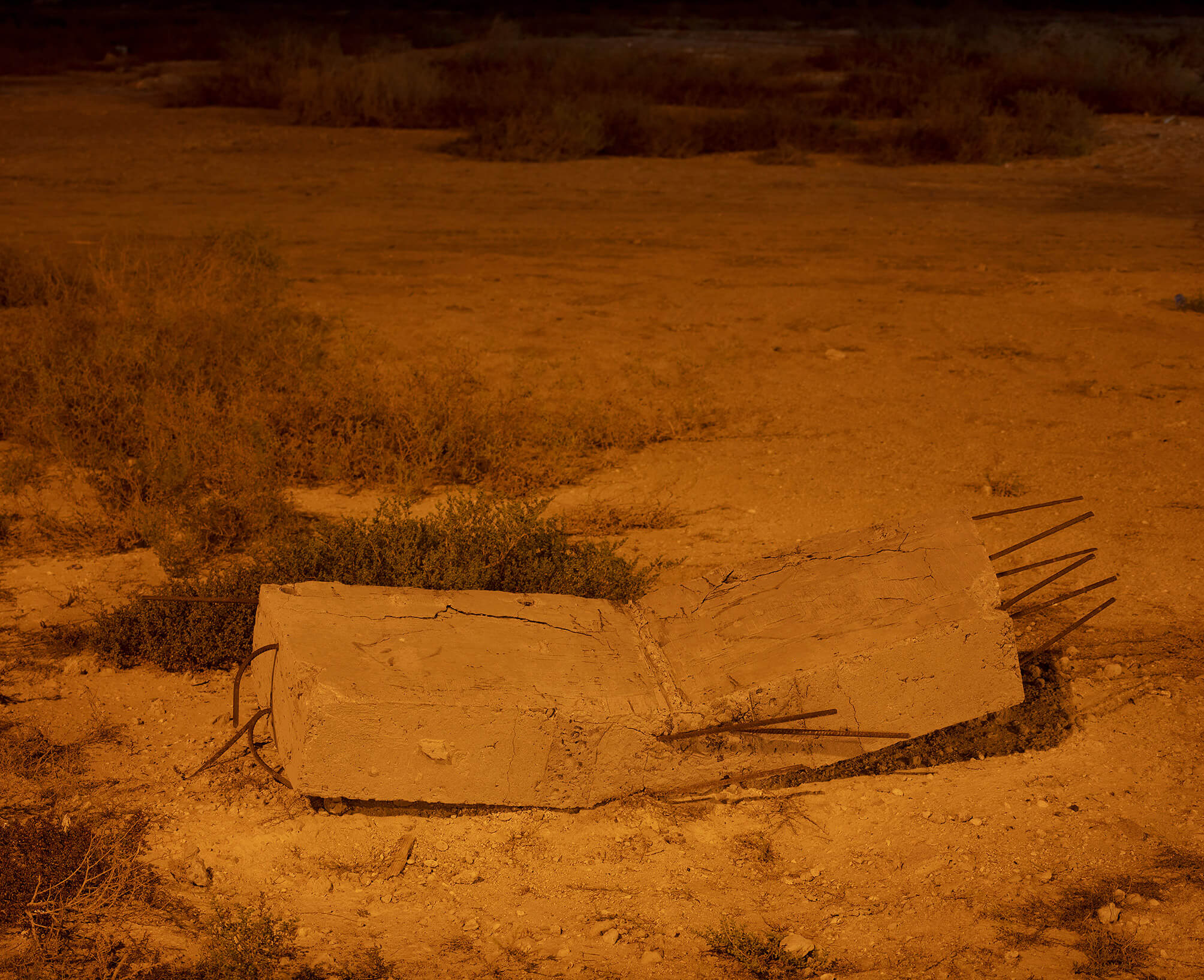
Depending on the perspective one chooses to look at the address, the house is adorned or not. The perspective from the main road is an image made in August 2020, the website (Google Maps) says. Our car is in front of the garage. It must be the end of August. We drive home from the hospital with the newborn, who doesn’t stop crying. Maybe I tightened the belts in the car seat too much. Arriving at our house, we see the slogans and decorations friends have hung at our front door. On the sill of the neighbour’s first floor window, there’s a brick that must have fallen from the second floor facade.
